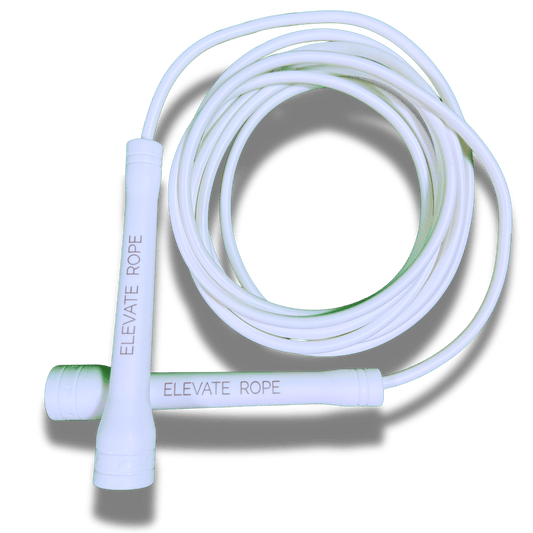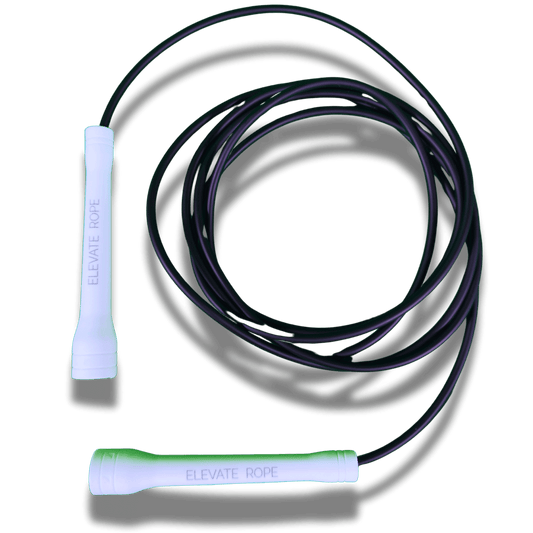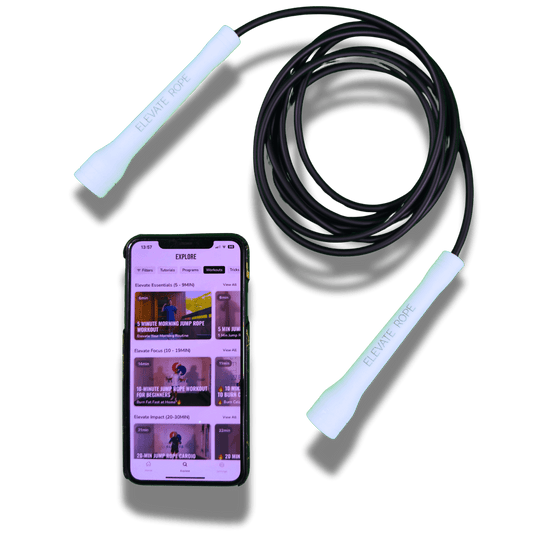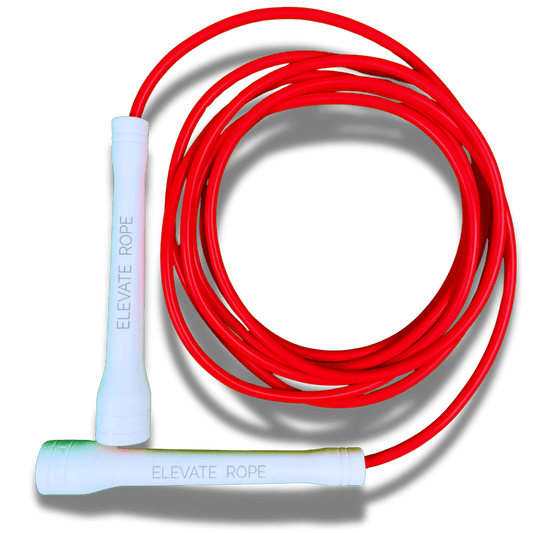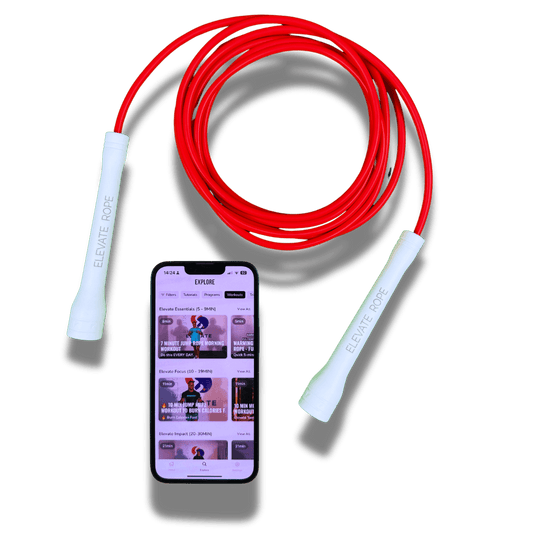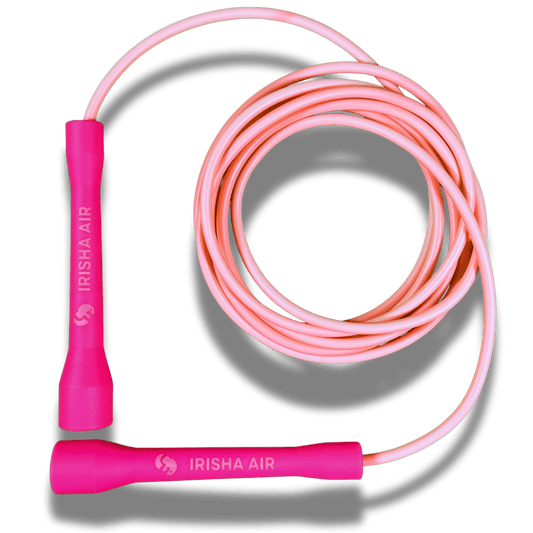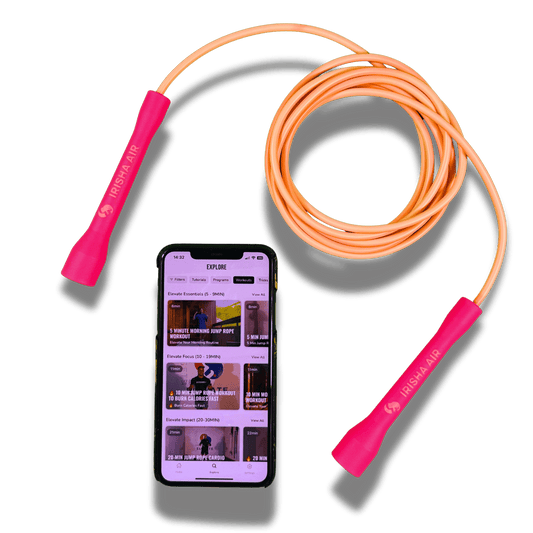
Sauter à la corde ne se résume pas à la vitesse et aux figures — il s'agit de bien bouger. Que vous poursuiviez les double unders, travailliez votre premier cross, ou ajoutiez simplement la corde à sauter à votre routine fitness, la mobilité est la base qui vous permet d'éviter les blessures liées à la corde à sauter et de performer au mieux. Pourtant, c’est l’élément que la plupart des sauteurs négligent… jusqu’à ce que la douleur les oblige à s’arrêter.
Des périostites tibiales aux épaules raides, les mauvais schémas de mouvement peuvent freiner vos progrès et transformer un entraînement amusant en un revers frustrant. La bonne nouvelle ? La plupart des blessures liées à la corde à sauter sont évitables — et la clé réside dans un travail de mobilité intelligent, une technique appropriée et une récupération stratégique.
Dans ce guide, nous décomposerons tout ce que vous devez savoir sur la mobilité à la corde à sauter et la prévention des blessures — de la compréhension des exigences de mouvement de votre corps, aux échauffements et exercices qui préparent vos articulations, jusqu'aux conseils pour éviter les erreurs courantes. Vous repartirez avec un plan étape par étape à utiliser avant, pendant et après vos séances pour mieux bouger, récupérer plus vite et sauter plus longtemps sans douleur.
Sautons plus intelligemment — pas seulement plus fort.
Comprendre la mobilité à la corde à sauter
Quand la plupart des gens pensent à améliorer leurs compétences à la corde à sauter, ils se concentrent sur la vitesse, l'endurance ou l'apprentissage de nouvelles figures. Mais il y a un ingrédient caché qui sépare les sauteurs fluides et sans douleur de ceux qui luttent constamment contre la fatigue ou les blessures : la mobilité.
Mobilité vs. Flexibilité — Quelle est la différence ?
Ces deux termes sont souvent utilisés de manière interchangeable, mais ils ne sont pas identiques.
- La flexibilité est votre capacité à allonger un muscle — pensez à la distance que vous pouvez atteindre pour toucher vos orteils.
- La mobilité est votre capacité à bouger activement une articulation sur toute son amplitude avec contrôle.
Vous pouvez être flexible sans être mobile, et vous pouvez être mobile sans une flexibilité extrême. Pour la corde à sauter, la mobilité est plus importante car il s'agit de mouvement fonctionnel sous contrôle — exactement ce dont vous avez besoin pour sauter en toute sécurité et efficacement.
Le rôle de la mobilité dans la performance à la corde à sauter
1. Efficacité du mouvement
Une bonne mobilité permet à vos articulations de travailler sur toute leur amplitude avec un minimum de restriction. Cela signifie moins d'énergie gaspillée, des rotations plus fluides et un atterrissage plus léger — autant d'éléments qui améliorent l'endurance et le rythme.
2. Réduction du risque de blessure
Une mobilité restreinte force d'autres muscles et articulations à compenser. Avec le temps, cela peut entraîner des blessures dues à la surutilisation comme les périostites tibiales, la tendinite d'Achille ou les tensions à l'épaule. Maintenir la mobilité permet à votre corps de bouger comme il a été conçu, réduisant le stress sur les zones vulnérables.
3. Plus grande endurance & capacité de compétence
Lorsque votre corps bouge efficacement, vous pouvez vous entraîner plus longtemps sans fatigue ni douleur. Plus de temps de pratique signifie une progression plus rapide des compétences et la capacité d'aborder des figures avancées en toute sécurité.
Exigences clés de mobilité pour la corde à sauter
Pour sauter efficacement et en toute sécurité, ces zones nécessitent une attention particulière :
- Chevilles (Dorsiflexion) : Essentielles pour l'absorption des chocs et une bonne mécanique d'atterrissage.
- Genoux & Hanches (Absorption des chocs) : Travaillent ensemble pour amortir chaque saut et maintenir l'équilibre.
- Épaules et poignets (contrôle de la corde) : Assurent des rotations de corde fluides et contrôlées sans mouvements inutiles des bras.
- Stabilité du tronc : Maintient votre posture droite, réduit la tension sur le bas du dos et permet des transitions de pieds plus rapides.
Comment la mobilité influence les figures et mouvements avancés
Les compétences avancées — comme les balancements latéraux, les croisements et les doubles sauts — nécessitent plus que de la force et de la coordination. Sans une mobilité adéquate des épaules et des poignets, les croisements sont maladroits. Sans mobilité des chevilles et des hanches, l'atterrissage des doubles sauts devient lourd et inefficace. Améliorer la mobilité permet de maîtriser ces compétences plus rapidement et avec moins de risques de blessure.
Idées reçues courantes sur la mobilité à la corde à sauter
L'un des plus grands mythes est, « Je n'ai pas besoin de travail de mobilité à moins de faire des figures avancées. » La réalité ? Même les pas de base reposent sur un mouvement fluide des articulations. Une mauvaise mobilité affecte le timing des sauts, augmente l'impact à l'atterrissage et limite les progrès — quel que soit votre niveau.
La mobilité n'est pas un « bonus » ajouté à votre entraînement. C'est une compétence fondamentale qui soutient chaque saut, chaque rotation et chaque atterrissage. Sans elle, même les jambes les plus fortes et la corde la plus chère ne vous mèneront pas très loin.

Les blessures et causes les plus courantes liées à la corde à sauter
La corde à sauter est l'un des entraînements les plus efficaces et agréables que vous puissiez faire — mais comme toute activité répétitive à fort impact, elle comporte des risques de blessure si vous négligez la technique appropriée, le travail de mobilité ou la récupération. Comprendre ces blessures et leurs causes profondes est la première étape pour les prévenir.
Blessures dues au surmenage
Les blessures dues au surmenage surviennent lorsque de petites quantités de stress s'accumulent avec le temps sans récupération suffisante. Elles sont courantes chez les nouveaux sauteurs désireux d'augmenter trop rapidement le volume et chez les athlètes expérimentés qui négligent le repos.
-
Périostites tibiales
Une douleur aiguë ou sourde le long de l'avant ou de l'intérieur du tibia, souvent causée par des sauts excessifs sur des surfaces dures ou une mauvaise mécanique d'atterrissage. Des mollets tendus et une mobilité limitée de la cheville aggravent cela. -
Tendinite rotulienne (genou du sauteur)
Douleur juste en dessous de la rotule due au stress répétitif sur le tendon rotulien. Cela provient souvent d'une mauvaise absorption des chocs, de sauts trop hauts ou d'une augmentation rapide du volume d'entraînement. -
Tendinite d'Achille
Inflammation du tendon à l'arrière de la cheville, souvent causée par un surentraînement, des mollets tendus ou des chaussures inappropriées. Cela peut prendre des semaines à guérir si ce n'est pas traité rapidement.
Blessures liées à l'impact
Celles-ci surviennent soudainement, souvent à cause d'un faux pas, d'une surface inadaptée ou d'un mouvement inattendu.
-
Entorses de la cheville
Une torsion ou une entorse de la cheville qui étire ou déchire les ligaments. Les terrains irréguliers ou les surfaces glissantes sont des coupables fréquents. -
Fractures de stress
Petites fissures dans l'os dues à des impacts répétitifs, souvent au niveau du tibia ou du pied. Généralement causées par un excès d'activité trop rapide sur des surfaces dures sans chaussures appropriées ni repos.
Problèmes de forme & technique
Beaucoup de blessures ne sont pas dues à la « mauvaise chance » mais à des schémas de mouvement qui exercent une tension inutile sur le corps.
-
Mauvaise posture
Se pencher trop en avant, voûter les épaules ou ne pas engager le tronc déplace l'impact des muscles amortisseurs vers les articulations vulnérables. -
Hauteur de saut incorrecte
Sauter trop haut gaspille de l'énergie et augmente les forces d'atterrissage sur les genoux, les tibias et les chevilles. La hauteur optimale est seulement de 2 à 3 cm du sol.
Causes liées à l'équipement
Même la meilleure technique ne peut pas vous protéger complètement si votre équipement joue contre vous.
-
Longueur de corde incorrecte
Une corde trop courte vous oblige à vous pencher, tandis qu'une corde trop longue encourage l'écartement des bras et un mouvement inefficace — ce qui augmente la tension sur les articulations. Nous recommandons une corde à sauter rapide pour des mouvements rapides avec des figures. -
Chaussures ou surface inappropriées
Chaussures avec un mauvais amorti ou une usure excessive ne parviennent pas à absorber les chocs. Sauter sur du béton sans tapis peut multiplier le stress sur vos os et tendons.
Facteurs saisonniers & environnementaux
-
Fatigue liée à la chaleur (été)
Les températures élevées peuvent accélérer la déshydratation et la fatigue musculaire, ce qui augmente le risque d'atterrissages maladroits et de blessures. -
Surfaces extérieures glissantes
La pluie, la rosée du matin ou les sols de gym polis réduisent l'adhérence et augmentent le risque de chutes ou d'entorses de la cheville.
Signes avant-coureurs précoces à ne pas ignorer
La plupart des blessures graves commencent par un inconfort léger et gérable. Traitez-les tôt pour éviter de longues périodes de récupération :
- Douleur persistante qui s'aggrave avec l'activité
- Gonflement ou raideur localisés
- Douleurs aiguës et lancinantes pendant ou après les sauts
- Amplitude de mouvement réduite aux chevilles, genoux ou épaules
La douleur n'est pas une marque d'honneur — c'est la façon dont votre corps demande des ajustements. Reconnaître et réagir à ces signes tôt peut faire la différence entre un jour de repos court et des semaines sur la touche.
Protocole d'échauffement et de préhabilitation pour la mobilité
Avant de prendre votre corde, considérez votre corps comme un moteur. Vous ne mettriez pas l'accélérateur à fond dans une voiture froide — et vous ne devriez pas commencer un saut intensif sans préparer d'abord vos articulations et muscles. Un bon échauffement améliore non seulement la performance, il prépare votre corps à prévenir les blessures.
Voici un protocole d'échauffement et de préhabilitation étape par étape conçu spécifiquement pour les athlètes de corde à sauter, des débutants aux maîtres des figures avancées.
Principes d'un bon échauffement à la corde à sauter
1. Augmentez le flux sanguin
Votre objectif est d'augmenter légèrement votre fréquence cardiaque et d'échauffer vos muscles pour qu'ils soient plus souples et réactifs. Cela réduit le risque d'élongations et de déchirures.
2. Utilisez des schémas de mouvement dynamiques
L'étirement statique avant une activité à fort impact peut temporairement réduire la puissance. Concentrez-vous plutôt sur la mobilité dynamique — bouger les articulations dans leur amplitude de manière contrôlée et active.
3. Préparez-vous pour les mouvements que vous ferez réellement
Un échauffement à la corde à sauter doit cibler précisément les articulations et groupes musculaires que vous utiliserez : chevilles, genoux, hanches, épaules, poignets et tronc.
Exercices de mobilité dynamique (environ 4–5 minutes)
Effectuez chaque exercice pendant 30–45 secondes. Ils peuvent être réalisés en séquence sans pause pour plus d'efficacité.
- Cercles de cheville & Élévations de mollets Tenez-vous sur une jambe et faites lentement tourner votre cheville dans les deux sens. Continuez avec des élévations de mollets contrôlées pour solliciter les mollets et le tendon d'Achille.Pourquoi : Améliore la dorsiflexion de la cheville et prépare les jambes inférieures aux impacts répétitifs.
- Ouvertures de hanches Debout, levez le genou à la hauteur de la hanche, faites-le pivoter vers l'extérieur, puis redescendez. Répétez vers l'intérieur. Pourquoi : Mobilise les hanches pour des atterrissages plus fluides et des transitions de jeu de jambes.
- Désarticulations d'épaules avec corde Tenez votre corde à sauter avec une prise large. Gardez les bras droits et amenez la corde au-dessus de la tête puis derrière le dos, puis inversez. Pourquoi : Ouvre la poitrine, augmente l'amplitude des épaules et prépare à la mécanique de rotation de la corde.
- Rotations de la colonne thoracique Tenez-vous debout, pieds écartés à la largeur des hanches, mains jointes devant. Tournez le haut du corps à gauche et à droite, en gardant les hanches stables. Pourquoi : Améliore la mobilité en rotation, utile pour les crossovers et les balancements latéraux.
- Rotations des poignets Tendez les bras vers l'avant, faites tourner les poignets dans le sens des aiguilles d'une montre, puis dans le sens inverse. Pourquoi : Améliore le contrôle de la corde et réduit la fatigue des avant-bras.
Exercices d'activation musculaire (environ 3 à 4 minutes)
Ces exercices « activent » les muscles qui vous stabilisent lors des sauts. Effectuez 10–15 répétitions chacun.
- Ponts fessiers Allongez-vous sur le dos, genoux pliés, pieds à plat. Poussez sur les talons pour soulever les hanches jusqu'à ce que votre corps forme une ligne droite des genoux aux épaules. Redescendez lentement. Pourquoi : Active les fessiers pour une meilleure absorption des chocs et protection des genoux.
- Gainage du tronc Tenez-vous droit, contractez vos abdominaux comme si vous vous prépariez à recevoir un coup, maintenez 5 secondes, relâchez, et répétez. Progression : Faites des planches ou des dead bugs pour une activation supplémentaire. Pourquoi : Maintient votre torse stable, réduisant la tension dans le bas du dos.
Micro-mobilité entre les séries
Le travail de mobilité ne se limite pas au début de votre séance. Ajouter des « resets » entre les séries permet de garder vos articulations mobiles et évite la raideur.
Exemples :
- Petits sauts sur place : Petits bonds doux sur place pour maintenir l'élasticité.
- Rotations d'épaules : Détendez la tension entre les tentatives de figures.
- Balancements de hanches : Balancements avant-arrière pour garder les hanches mobiles pour les exercices de jeu de jambes.
Ces mini-sessions ne durent que 10 à 20 secondes mais peuvent faire une grande différence dans la sensation de fraîcheur de votre corps après un long entraînement.
Mettre Tout Ensemble (Exemple d'échauffement de 8 minutes)
- Jogging sur place ou saut léger à la corde – 60 secondes (circulation sanguine)
- Cercles de cheville & élévations de mollets – 30 sec chaque jambe
- Ouvertures des hanches – 30 secondes dans chaque direction
- Désarticulations des épaules avec corde – 10 répétitions
- Rotations de la colonne thoracique – 10 répétitions de chaque côté
- Rotations des poignets – 15 secondes dans chaque direction
- Ponts fessiers – 12 à 15 répétitions
- Maintiens de gainage du tronc – 5 répétitions, 5 secondes chacune
Stratégies de prévention des blessures
La meilleure façon de récupérer d'une blessure est de ne jamais en avoir. Bien que le travail de mobilité et l'échauffement posent les bases, la véritable prévention des blessures consiste à combiner une technique intelligente, un travail de force ciblé et une récupération structurée. Voici comment garder votre entraînement à la corde à sauter sûr, durable et sans douleur.
Perfectionner la technique de la corde à sauter
1. Vérification de la longueur de la corde
Une corde trop longue vous oblige à écarter les bras et à pivoter des épaules, tandis qu'une corde trop courte vous fait vous pencher en avant — les deux augmentent la tension sur les articulations.
- Test rapide : Tenez-vous au centre de la corde et tirez les poignées vers le haut. Elles devraient atteindre environ la hauteur des aisselles.
2. Hauteur de saut minimale
Plus vous sautez haut, plus votre corps absorbe d'impact à chaque atterrissage — et plus vous vous fatiguez rapidement. Le saut idéal est 2 à 3 cm au-dessus du sol, juste assez pour que la corde passe sous vos pieds.
3. Atterrir en douceur sur le milieu du pied
Évitez d'atterrir sur vos talons (ce qui secoue vos genoux) ou uniquement sur vos orteils (ce qui sollicite les mollets). Un atterrissage doux sur le milieu du pied répartit la force de manière uniforme et permet à vos chevilles d'agir comme des amortisseurs naturels.

Entraînement de force pour la prévention
Renforcer les muscles autour de vos articulations réduit le risque de blessures dues à la surutilisation et améliore la stabilité lors des figures. Visez 2 à 3 courtes séances de renforcement par semaine.
-
Élévations des mollets
Renforce les mollets et le tendon d'Achille pour une meilleure tolérance aux impacts. -
Squats
Développe la force des quadriceps, ischio-jambiers et fessiers pour soutenir le genou et les décollages explosifs. -
Travail de stabilité sur une jambe (par exemple, soulevés de terre sur une jambe, maintien de l'équilibre)
Améliore la stabilité de la cheville et de la hanche, vous rendant plus résistant aux surfaces inégales ou aux atterrissages maladroits.
Sélection de la surface et chaussures
- Choisissez des surfaces tolérantes : Les planchers en bois, tapis de gym ou sols sportifs amortissants aident à absorber l'impact. Évitez les longues séances sur du béton sans tapis protecteur.
- Portez des chaussures de soutien : Cherchez des semelles intermédiaires amortissantes et un talon stable. Remplacez les chaussures tous les 300 à 500 km d'utilisation pour maintenir l'absorption des chocs.
Gestion de la charge
Les blessures surviennent souvent non pas à cause d'une mauvaise séance, mais parce que vous augmentez la charge d'entraînement trop rapidement.
- Volume hebdomadaire : Augmentez le temps total de saut ou les rotations de pas plus de 10 % par semaine.
- Durée de la séance : Les débutants peuvent commencer par 5 à 10 minutes par jour et augmenter progressivement.
- Vagues d'intensité : Alternez les jours durs et faciles pour donner à votre corps le temps de s'adapter.
Importance des jours de repos et de récupération
Le repos n'est pas un « saut d'entraînement » — c'est le moment où vos muscles se réparent et deviennent plus forts. Sauter le repos est l'une des voies les plus rapides vers l'épuisement et la blessure.
- Planifiez au moins 1 à 2 jours de repos par semaine loin de l'entraînement à la corde à sauter.
- Utilisez la récupération active : vélo léger, étirements ou marche pour favoriser la circulation sanguine sans impact élevé.
- Priorisez le sommeil : visez 7 à 9 heures par nuit pour une réparation optimale des tissus et un équilibre hormonal.
Conseil pro : Écoutez votre corps. De petites douleurs qui persistent plus de 48 heures sont un signe pour réduire l'intensité, modifier les mouvements ou vous reposer complètement. Ignorer les premiers signes d'alerte peut transformer un problème mineur en un revers majeur.
En combinant technique de précision, travail de renforcement des articulations, choix intelligents de surface, et récupération structurée, vous créez un environnement d'entraînement où votre corps peut donner le meilleur de lui-même — et le rester sur le long terme.
Récupération & mobilité post-entraînement
Votre entraînement n'est pas vraiment terminé lorsque vous posez la corde. La récupération est le pont entre l'entraînement d'aujourd'hui et la performance de demain — et la négliger peut annuler une grande partie de votre travail acharné. Une courte routine de retour au calme ciblée aide vos muscles à retrouver leur longueur de repos, réduit les courbatures et maintient la mobilité fluide de vos articulations.
Étirements post-séance (5–7 minutes)
Maintenez chaque étirement pendant 20–30 secondes de chaque côté, en respirant lentement et en évitant tout rebond.
- Mollets – Reculez un pied, talon au sol, et penchez-vous doucement vers l'avant pour allonger les muscles gastrocnémien et soléaire.
- Quads – Debout, tirez une cheville vers vos fessiers tout en gardant les genoux proches pour étirer l'avant de la cuisse.
- Ischio-jambiers – Tendez une jambe vers l'avant, penchez-vous au niveau des hanches et atteignez vos orteils sans arrondir le dos.
Ces étirements aident à restaurer la flexibilité, améliorer la circulation et empêcher les muscles du bas de la jambe de se raidir — un facteur majeur pour prévenir les périostites et les problèmes de tendons.
Auto-libération myofasciale (3–5 minutes)
Le foam rolling aide à libérer la tension musculaire, améliorer la circulation sanguine et accélérer la récupération entre les séances.
- Mollets – Roulez de l'Achille jusqu'à juste en dessous du genou, en vous arrêtant sur les zones tendues.
- Quads – Allongé face contre terre, roulez de la hanche jusqu'au-dessus du genou.
- IT Band – Allongé sur le côté, roulez de l'extérieur de la hanche jusqu'au-dessus du genou. (Conseil : Cela peut être intense — allez-y doucement et contrôlez votre pression.)
Hydratation & Nutrition pour la santé des articulations
- Hydratation : Reconstituez les fluides perdus par la transpiration pour garder les articulations lubrifiées et les muscles bien fonctionnels. Ajoutez des électrolytes si vous vous entraînez par temps chaud.
- Nutrition : Visez un repas ou une collation post-entraînement équilibré avec des protéines (réparation musculaire), des glucides (restauration du glycogène) et des aliments anti-inflammatoires comme les baies, les légumes à feuilles ou les poissons riches en oméga-3.
Le sommeil comme carburant de récupération
Le sommeil est le moment où votre corps effectue ses réparations les plus profondes — reconstruisant le tissu musculaire, restaurant l'énergie et régulant les hormones.
- Visez 7 à 9 heures par nuit.
- Gardez une heure de coucher régulière pour améliorer la qualité du sommeil.
- Limitez les écrans au moins 30 minutes avant le coucher pour favoriser un meilleur repos.
Considérez la récupération comme une partie de votre entraînement, pas comme un supplément optionnel. Juste 10 à 15 minutes de travail de récupération peuvent améliorer considérablement votre ressenti demain — et vos performances à long terme.
Dépannage : que faire si vous êtes déjà blessé
Même avec le meilleur plan de prévention, les blessures peuvent survenir — parfois à cause d'une mauvaise réception, parfois à force de trop forcer. L'essentiel est de savoir comment réagir pour guérir rapidement et en toute sécurité.
Quand se reposer ou modifier l'activité
- Reposez-vous complètement si vous ressentez une douleur aiguë, un gonflement ou tout mouvement qui aggrave la douleur. Continuer à sauter malgré ces signes peut transformer un problème mineur en blessure à long terme.
- Modifiez l'activité si l'inconfort est léger et n'apparaît que lors de certains mouvements. Cela peut signifier réduire l'intensité, diminuer le temps de saut ou remplacer par des exercices alternatifs.
Alternatives à faible impact au saut à la corde
Vous n'avez pas à abandonner complètement votre corde pendant la récupération.
- Balancements latéraux – Faites balancer la corde d'un côté à l'autre sans sauter pour maintenir le rythme et l'activité des épaules.
- Mouvements lents des pieds – Pas légers sur un seul côté ou tapotements du talon avec un rebond minimal pour garder votre corps engagé sans impact important.
Quand consulter un professionnel
Si la douleur persiste plus de 7 à 10 jours, s'aggrave avec le temps ou limite les activités quotidiennes, consultez un physiothérapeute ou un professionnel de la médecine du sport. Une intervention précoce peut prévenir les problèmes chroniques.
Plan progressif de retour à la corde
Une fois sans douleur dans les mouvements quotidiens :
- Commencez par des séances courtes et de faible intensité (2–3 minutes).
- Concentrez-vous sur une forme parfaite et une faible hauteur de saut.
- Augmentez le volume total de pas plus de 10% par semaine jusqu'à revenir à votre routine normale.
Rappelez-vous : Prendre une courte pause maintenant est toujours mieux que d'être mis sur la touche pendant des mois plus tard. Écoutez votre corps, respectez le processus de guérison, et reprenez l'entraînement avec intention.
Conseils d'experts de la communauté Elevate Rope
L'un des meilleurs aspects du mouvement Elevate Rope est notre communauté mondiale de sauteurs — des amateurs de fitness occasionnels aux performeurs de classe mondiale. Nous avons demandé à certains de nos membres et entraîneurs les plus expérimentés de partager leurs meilleurs conseils de mobilité et de prévention des blessures, et voici ce qu'ils ont dit :
« La mobilité ne sert pas qu'aux échauffements. Je prends 2 à 3 minutes entre les séries intenses pour rouler mes épaules et rebondir sur mes chevilles. Cela garde ma forme nette toute la séance. »
– Alex M., sauteur de vitesse compétitif
« N'attendez pas la douleur pour commencer à vous étirer. Dix minutes par jour pour les hanches, les mollets et les épaules ont changé la donne pour mon endurance. »
– Priya S., groupe finstructeur de fitness
« Je pensais que les jours de repos étaient des jours perdus. Maintenant, je sais que c'est quand mes compétences s'améliorent vraiment. Programmez-les comme des entraînements — ils sont non négociables. »
– James K., athlète de corde freestyle
« Investissez dans la bonne surface. Je transporte un tapis portable pour les séances en extérieur — il a sauvé mes tibias et m'a permis de m'entraîner régulièrement toute l'année. »
–Maria L., ambassadrice Elevate Rope
Ces idées ne sont pas que de la théorie — ce sont des habitudes que notre communauté applique. Elles montrent que la mobilité, la récupération et des choix d'entraînement intelligents permettent aux sauteurs de progresser sans revers.
Chez Elevate Rope, nous croyons que la compétence et la performance reposent sur une base de mouvement sain. Que vous pratiquiez les double unders dans le parc ou des combos freestyle dans votre salon, ces conseils de vrais sauteurs prouvent que de petites actions quotidiennes peuvent avoir un impact énorme sur votre longévité dans le sport.
Conclusion
La mobilité n'est pas un extra optionnel — c'est la base de la performance. Chaque rotation fluide, atterrissage doux et figure propre que vous maîtrisez commence par des articulations qui bougent bien et des muscles qui travaillent en harmonie. En faisant de la mobilité et de la prévention des blessures une partie de votre entraînement, vous ne faites pas que prévenir les revers — vous débloquez tout votre potentiel de saut à la corde.
Un entraînement proactif signifie s'échauffer avec un but, bouger avec intention, et récupérer comme si cela comptait — parce que c'est le cas. Les sauteurs les plus performants ne sont pas seulement habiles ; ils sont constants, et la constance vient du fait de rester suffisamment en bonne santé pour s'entraîner semaine après semaine.
Maintenant, c'est votre tour. Intégrez ces échauffements, exercices et habitudes de récupération dans vos séances, et regardez vos performances, votre endurance et votre plaisir s'envoler.
Prêt à sauter plus intelligemment ? Prenez votre and mettez ce guide en action. Plus vous commencez à bouger correctement tôt, plus vous pourrez continuer à bouger longtemps — et mieux.





